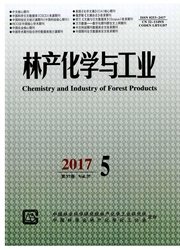

 中文摘要:
中文摘要:
为优化生物质热裂解产物中左旋葡聚糖(LG)产率,在改进的B-S机理模型的基础上,以纤维素热裂解为研究对象,对其热裂解过程中活性纤维素(AC)、LG以及乙醇醛(HAA)的演变和生成情况进行了模拟.结果发现纤维素热裂解过程中,由于一次反应吸热需求得不到满足,导致物料温度长时间内处于中温状态,恰好形成了生物质热裂解制取生物油保持中温的必要条件.作为纤维素热裂解最主要的产物,LG在物料内部并未发生强烈的二次裂解,HAA则几乎完全来源于AC的分解,物料内部LG和其他竞争产物浓度(质量浓度,下同)的区别主要取决于其竞争能力的大小,HAA浓度积累速度在反应后期的提高正是其竞争消耗AC优势的体现.挥发分二次反应主要发生在气相空间,随着气相停留时间和辐射源温度的增加,LG二次分解的程度提高.因此为获取高产率LG,中等辐射源温度和短气相停留时间是必要条件,仅以生物油产率为目的时,气相停留时间可适当放宽.
 英文摘要:
英文摘要:
In order to optimize the yield of levoglucosan (LG) during cellulose pyrolysis, a model based on modified Brodio- Shafizadeh (B-S) mechanism model was brought out to simulate the process of decomposition and formation of active cellulose, LG and hydroxyl-acetaldehyde (HAA). Simulation results show that cellulosic material is constrained in a middle temperature condition during a rather long period of time, since heat transferred from the surrounding can not meet the endothermic need of primary cracking reaction, which virtually forms the essential condition for biomass pyrolysis to yield bio-oil. Being the most important product of cellulose pyrolysis, LG does not undergo any intensive secondary cracking, while almost all HAA is originated from the decomposition of AC. In addition, concentration differences among LG and other competitive compounds in fabric structure are determined by the competitive abilities of the corresponding reactions. This is validated by the increased accumulation tendency of HAA concentration during the late period of pyrolysis process,indicating its superiority to LG formation in consumption of AC. Secondary reactions of volatiles occur largely in gaseous phase rather than in solid phase, Both long residence time of volatiles and high temperature will induce high decomposition of LG. Therefore, to optimize the yield of LG, middle radiantsource temperature and short gas residence time are necessary. In order to optimize the yield of bio-oil, gas residence time can be slightly longer.
 同期刊论文项目
同期刊论文项目
 同项目期刊论文
同项目期刊论文
 期刊信息
期刊信息
